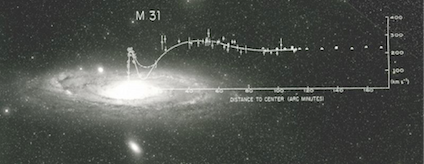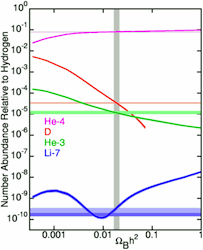Astronomy 129: Cosmology
Archive of Assignments
Week 12
posted 12/2
I've added a few specific topics for the last presentation, on Sec. 5: the physics of inflation, so look over the full version of the assignment [pdf]. That Sec. 5 information is the only thing that's changed. Each person should volunteer to give one of the presentations or solve one of the problems.
posted 11/28
Read Ch. 11, on inflation for next week's seminar. There are presentations (related directly to the material in the textbook reading) and problems (write-ups due Tuesday afternoon; just for three problems) in the seminar assignment. Note that will add one or two presentations for sec. 5, so the assignment is not quite complete yet.
Week 11
posted 11/16
I've updated the assignment for this week [pdf]. None of the questions have changed and no new ones have been added, but I have added two research papers (Coc et al. 2014 and Savage et al. 2007) for you to read very small parts of. Please note that I ask you to look for a couple of specific things in each paper. Expect to discuss these in our seminar meeting.
posted 11/14
The assignment for this week is on Big Bang Nucleosynthesis (BBN), which is one of the strong pieces of evidence for the Hot Big Bang model, and which gives us a completely independent measurement of Omega_baryon. Note that write-ups are due on Tuesday at 11:00 pm (pm!).
Please look back at the links about CMB anisotropies, now on the archive page, and let me know if you have any questions. Look again at the cartoon/movie we looked at at the very end of seminar showing synthetic maps of the anisotropies but only the contributions from a restricted range of spherical harmonics: pdf or mov.
New: Check out the composite observed spectral energy distribution for the universe as a whole. It shows how much the CMB dominates. And: If you need convincing about the possibility of multiple or parallel universes [pdf].
Week 10
posted 11/7
The assignment for this week [pdf] is now available. Note that write-ups for five questions are due on Tuesday afternoon at 3:00.
For your convenience, here are the links in the assignment, collected in one place:
Wayne Hu's tutorial
sky maps
WMAP
Planck
anisotropies and geometry
spherical harmonics (Java has to be installed and updated)
CMB power spectrum analyzer
Re-writes of problems 3 and 5 from last week were due on Friday at 5pm.
Purely optional - following up on week 9 topics, you might be interested in a two page article on making visualizations of dark matter distributions, a one page essay on the anthropic principle and multiple universes, Lee Smolin on cosmic natural selection as an explanation for our fine-tuned universe (and a couple of interesting letters in response to Smolin's article). Also, here's the Wikipedia page on weak gravitational lensing, with that illustrative figure. New: The idea that the vacuum of empty space has non-zero energy is an experimentally verified fact, via measurements of the Casimir effect. The first few paragraphs of that article are also a good, very basic overview of the ideas that form the basis of quantum field theory.
Week 9
posted 11/1
The complete assignment for this week is now available. Note that answers to a few written questions are due on Tuesday by 1PM. And you have to post questions about the Carroll reading and also, separately, about the paper on the Bullet Cluster. I will set up two separate forums on our Moodle site.
Although the links are in the assignment, for completeness sake, here is the paper on the Bullet Cluster, "A Direct Empirical Proof of the Existence of Dark Matter," Clowe et al. Ap.J., 648, L109 (2006) and the Physics Today article [pdf].
posted 10/31
As you're reading Ch. 8, look over these images, showing flat rotation curves, hot gas in galaxy clusters, and examples of gravitational lensing [pdf]. There are fewer than ten of them.

We'll be reading Ch. 8, on dark matter this week. Right at the beginning, Ryden notes that the Type Ia supernova evidence for an accelerating universe, giving Omega_m = 0.3 and Omega_Lambda = 0.7, provides good constraints on the ratio of those two parameters (remind yourself of the expression for a_mLambda, the scale factor when the two components were equal, and you'll see why), but allows for a range of Omega_m values. This can be seen in the final figure in Ch. 7 and in Fig. 8 in Riess et al. Study those figures and make sure you understand what they're showing. And let's revisit dark energy (the term for whatever it is that's making the universe accelerate) before we move on to dark matter.
There were a couple of your questions about the Riess paper that we didn't address in class. They were on the theoretical side - Stefan asked about how dark energy could evolve, and David asked about scalar fields and also why it's claimed that the cosmological constant has a phenomenally small value. This week, we're going to start by reading part of a paper that addresses the nature of dark energy and speculates about what it could be. The parts of the paper that summarize the observational mysteries of dark energy, framing it within the context of general relativity, and then address whether the observations are perhaps being misinterpreted are definitely worth reading. The paper then goes on to address various scenarios for explaining the acceleration. I'll ask you to read just a few paragraphs in those later parts of the paper. So, to begin this week's assignment, read the first nine pages of Why is the Universe Accelerating, by Sean Carroll, up through the end of sec. 1.3.1. Then read the first few paragraphs of sec. 1.3.3 "Is dark energy dynamical?" and the first few paragraphs of sec. 1.3.4 "Did we just get lucky?" You can also read the first few paragraphs of sec. 1.3.5 "Are we witnessing environmental selection?" and of course, you can read all the parts I didn't assign, too (but they contain more arcane and speculative physics- raising many questions that I can't answer, so we'll focus our discussion on the parts I assigned). I'll ask you to post a first round of questions about this paper by Sunday night.
Stay tuned for the rest of the assignment. But please go ahead and start reading the Carroll article.
Week 8
posted 10/26
This week's assignment is available. You'll hand in a copy of your work at the beginning of seminar, and then (re-)write-ups of some of the problems will be due the Friday after seminar. Update: no re-writes of the problems are required.
Week 7
posted 10/20
The midterm, in class during regular seminar meeting time (David will bring snacks), will be closed book. However, you should prepare a sheet of notes, equations, sketches, that you can bring with you to the exam. The notes must be hand-written/drawn by you, and can be on both sides of an 8.5 by 11 inch piece of paper.
Updated 10/21: Some additional information about the midterm —
You should bring a calculator, but you will not have to do any heavy-duty math/graphing with it. And generally you will not have to solve any difficult integrals (just some easy ones). The exam is not about math; it's about physics, astrophysics, and cosmology. But, obviously, solving quantitative problems - and interpreting them - will be a major component of the exam.
The exam will focus on basic stuff: how to solve/interpret the Friedmann and acceleration equations to figure out the properties of a given universe; computing important properties of objects in a given universe (e.g. their proper distances or the time elapsed since they emitted the light we see); concepts such as horizon distance, look back time, and the critical density are things you should be able to explain and employ; and there may be basic applications of (non-Euclidean) geometry. But the exam will not cover any of the GR material from week 3.
Week 6
posted 10/3
The full assignment for week 6 is now available. There are eight problems, all due in seminar on Wednesday. Update: solutions are to be handed in by Friday and will be graded.
Week 5
posted 9/26
The assignment for week five is partly ready. Read this partial version of assignment 5. More notes, related to the second half of the chapter, will be posted later today or (more likely) tomorrow. Update 9/28: OK, the full assignment for week 5 is now available.
Week 4
posted 9/18
Have a look at this reading assignment and problems for our next seminar meeting.
Week 3
posted 9/16
Spend a couple of minutes looking over these images showing light traveling on curved paths through warped space before coming to seminar tomorrow.
posted 9/15
Tristan's first reading is Ch. 12 from Harrison's Cosmology. And he sent out two questions with it. He also sent out a second, shorter reading, that consists of notes that he wrote along with some questions interspersed. You should come to seminar ready to discuss the concepts and solve the problems, but you won't hand anything in this week.
Week 2
posted 9/11
By Friday, Tristan will send out a GR assignment.
posted 9/8
This week's reading is chapter 3 of Ryden's An Introduction to Cosmology (as well as review of the end of Ch. 2). To guide your reading and help you focus on the most important points, read this set of notes, questions, and problems [pdf] and then keep it at hand while you're doing the reading. The five problems you have to write up do not need to be handed in ahead of time, but do bring do copies of them to seminar — one to hand in at the beginning of class and one to look at as we discuss the material and the solutions to the problems.
Week 1
posted 9/3
Take another look at the Hubble Ultra-Deep Field.
posted 8/29
Our first seminar meeting will focus on the material in chapters 1 and 2 of Ryden's An Introduction to Cosmology. To guide your reading and help you focus on the most important points, please first read this set of notes, questions, and problems [pdf] and then keep it at hand while you're doing the reading. This assignment includes important things to look out for as you read, things you should be ready to discuss or answer in class, and a few problems for you to solve and hand in the day before our seminar meeting. I will look them over, give you some feedback, and return them to you by 6pm on Tuesday. I expect you to look over my comments on Tuesday night or Wednesday morning to help you better prepare for and participate in our seminar discussion.
Since some of you may not yet have your textbook or immediate access to the one on reserve in Cornell, you can read these scanned pages from Ch. 1 and 2 [pdf].
Return to the main class page.
This page is maintained by David Cohen
cohen -at- astro.swarthmore.edu
Last modified: December 6, 2014
